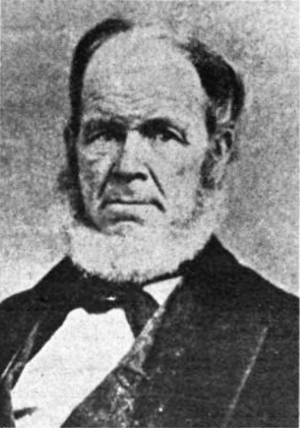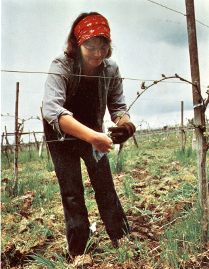History of Oregon wine facts for kids
The history of wine production in Oregon started even before Oregon became a state. Settlers planted grapes as early as the 1840s. However, making wine became a big industry in Oregon only in the 1960s. Oregon wines first became famous in the late 1970s. By 2015, Oregon had 702 wineries and over 28,000 acres of grapevines planted.
Contents
Early Days: From Settlers to Prohibition
The first grapes in Oregon were planted in 1847 by Henderson Luelling. He was a plant expert who traveled to Oregon on the famous Oregon Trail. The first recorded winery, Valley View Vineyard, opened in Jacksonville in the 1850s. This was before Oregon officially became a state in 1859.
In 1860, the first Oregon count showed that about 11,800 liters (2,600 gallons) of wine were made. In the 1880s, many new people in Southern Oregon tried growing different types of grapes. By 1899, Oregon vineyards grew 2,694 tons of grapes! A winemaker named Ernest Reuter from Forest Grove even won a silver medal at the 1904 St. Louis World's Fair.
Middle 1900s: A Quiet Time
Wine production in Oregon, like in other parts of the United States, stopped during the Prohibition Era. This was a time when making and selling alcohol was against the law. When Prohibition ended in 1933, wine production started again.
For many years, the Oregon wine industry stayed small. Most of the wine made was from fruits other than grapes, or from different kinds of grapes. At this time, the California wine industry became very big because of its warmer climate. Only two Oregon wineries made wine from the main type of wine grape, called Vitis vinifera, and they did it on a small scale.
Rebirth: The 1960s and 1970s
The Oregon wine industry began to grow again in the 1960s. Richard Sommer opened Hillcrest Vineyard near Roseburg in 1961. His first wines were sold in 1964. Sommer was one of the first to plant Pinot noir grapes in Oregon.
In the 1960s, other winemakers like David Lett and Charles Coury also started planting Pinot noir grapes in the Willamette Valley. In 1966, David Lett planted his vineyard, which became The Eyrie Vineyards.
By 1970, Oregon had five official wineries. Many winemakers from other states, especially California, moved to Oregon. These included Dick and Nancy Ponzi, Susan and Bill Sokol Blosser, and David and Ginny Adelsheim.
In 1973, Oregon passed an important land-use law. This law helped keep farmland separate from city areas. It stopped many hillsides, which are great for growing grapes, from being turned into houses.
In the 1970s, Oregon winemakers also started working together to promote their wines. They published books and brochures to share information about Oregon wines.
Oregon Wines Get Noticed
Big things happened in 1979 that made Oregon wines famous. A Pinot noir wine from Eyrie Vineyards placed in the top 10 at a competition in France called the Gault-Millau French Wine Olympiades. It was even rated the best Pinot noir! This showed that Oregon could make top-quality wines, not just Europe.
A French winemaker, Robert Drouhin, set up another competition. He wanted to see how Eyrie's Pinot noir would do against even better French wines. Eyrie's wine came in a very close second. This proved that Oregon wines were truly excellent.
Global Recognition: The 1980s
Oregon winemakers kept winning awards in the 1980s. By 1980, Oregon had 34 wineries and 115 grape growers. Even after the 1980 eruption of Mount St. Helens affected the 1980 grape harvest, two Oregon wines won gold medals in a London competition in 1982.
A famous wine critic, Robert M. Parker, Jr., visited Oregon in 1984 and was very impressed with the Pinot noir wines. In 1985, during a "Burgundy Challenge," wine experts couldn't tell the difference between Oregon and French Pinot noirs in a blind taste test. The Oregon wines were even rated higher!
The 1980s also saw more efforts to market Oregon wine. The Oregon Wine Advisory Board was created in 1983. In 1984, special wine regions called AVAs (American Viticultural Areas) were set up, including the Willamette Valley AVA.
Stronger connections grew between Oregon and Burgundy, a famous wine region in France. French wine experts worked with Oregon State University. This helped Oregon winemakers get access to special grape types. In 1987, the Drouhin family from Burgundy, a very respected winemaking family, bought land in Oregon and started Domaine Drouhin Oregon.
Modern Oregon Wine: 1990s and Beyond
By 1990, Oregon had 70 wineries and 320 grape growers. The industry faced a challenge when a tiny bug called Phylloxera was found in Oregon. This bug attacks grapevines. To fix this, vineyards had to use special grapevines that were resistant to the bug. Many vineyards used this chance to plant different grape types that would grow even better in their specific locations.
New laws in 1995 helped winemakers. They could now ship wine directly to customers in Oregon. Also, wine tasting in stores became legal, and wineries could host special events. In 1998, the wine industry added $120 million to Oregon's economy.
The 21st century has focused on "green" wine production in Oregon. Organizations like LIVE certify wineries for meeting environmental standards. Many Oregon vineyards and wineries are now certified for being environmentally friendly. In 2002, Oregon became a leader in green winemaking with some wineries getting special "LEED-certified" ratings for their eco-friendly buildings.
More AVAs were established in the 2000s, helping to define the unique wine regions of Oregon. The Oregon Wine Board was created in 2003 to help promote Oregon wines.
The Oregon Wine History Project started in 2010 at Linfield College. It keeps a large collection of Oregon wine history. In 2012, Oregon Public Broadcasting aired a documentary called Oregon Wine: Grapes of Place, which told the story of wine in Oregon.
By 2015, Oregon had grown to 702 wineries and 1052 vineyards, with over 28,000 acres of grapes planted.




